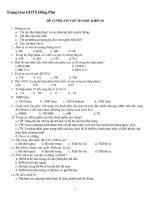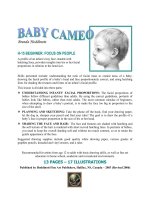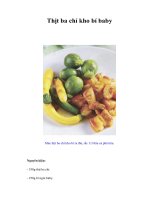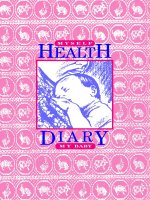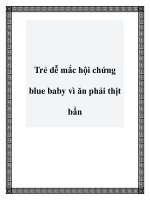Baby Curly
Bạn đang xem bản rút gọn của tài liệu. Xem và tải ngay bản đầy đủ của tài liệu tại đây (603.88 KB, 6 trang )
Brenda Hoddinott
D-04 BEGINNER: SQUIRKLING
This lesson provides you with lots of information and exercises to help you become familiar with
creating values and graduations with squirkles. You follow along with super simple illustrated
step-by-step instructions to draw an adorable cartoon baby with curly hair.
You first outline the shape of the baby’s face in the lower half of a square drawing space, and
add the eyes, eyebrows, nose, ears, and mouth. In addition to creating the texture of curly hair
with squirkles, you also use a graduation of squirkles to make the hair look three-dimensional.
Suggested drawing supplies include HB and 4B pencils, vinyl and kneaded erasers, good quality
drawing paper, a pencil sharpener, and a sandpaper block.
This lesson is recommended for artists of all ages and abilities, as well as home schooling,
academic and recreational fine art educators.
6 PAGES – 9 ILLUSTRATIONS
Published by Hoddinott Fine Art Publishers, Halifax, NS, Canada – Revised 2006
Copyright to all articles, images, text, projects, lessons and exercises within this drawing class belong to Brenda Hoddinott and may
not be reproduced or used for any commercial purposes whatsoever without the written permission of Brenda Hoddinott.
Web sites and
- 2 -
You first outline the shape of the baby’s face in the lower half of a square drawing space, and
add the eyes, eyebrows, nose, ears, and mouth. In addition to creating the texture of curly hair
with squirkles, you use a graduation of squirkles to make the hair look three-dimensional.
ILLUSTRATION 04-01
1. Draw a large square to represent
your drawing format.
Your square can be any size you
wish. Suggested sizes include 4
inches by 4 inches, 6 inches by 6
inches, or 8 inches by 8 inches.
2. Draw a wide U-shape to
represent the lower half of the
head.
Take note that this whole U-shape
(face) is totally within the lower
half of your drawing space.
Observe also that there is a slight
curve to each side of the face.
ILLUSTRATION 04-02
ILLUSTRATION 04-03
3. Outline two almond shaped eyes.
The eyes are very far apart, and
lower on the face than the
beginning point of the lines
indicating the sides of the face.
4. Draw a tiny circle in the upper
right section of each eye.
The inside of the tiny circles need
to remain white, so be careful not
to accidentally fill them in.
Copyright to all articles, images, text, projects, lessons and exercises within this drawing class belong to Brenda Hoddinott and may
not be reproduced or used for any commercial purposes whatsoever without the written permission of Brenda Hoddinott.
Web sites and
- 3 -
ILLUSTRATION 04-04
5. Use your 4B pencil to
shade in each eye.
Remember to leave the
small circle white. This
tiny white spot is called a
highlight, and helps make
the eye look shiny.
A highlight is the
brightest area of an eye
where light bounces off
its surface.
6. Draw a slightly curved
short line above each
eye to represent
eyebrows.
ILLUSTRATION 04-05
7. Draw an oval shape
between and slightly
below the eyes to
represent the nose.
8. Draw a slightly curved
line below the nose to
represent the mouth.
9. Add a tiny curved line
on each end of the
mouth.
10. Draw another curved
line slightly above the
bottom of the face to
represent a double chin.
Copyright to all articles, images, text, projects, lessons and exercises within this drawing class belong to Brenda Hoddinott and may
not be reproduced or used for any commercial purposes whatsoever without the written permission of Brenda Hoddinott.
Web sites and
- 4 -
ILLUSTRATION 04-06
11. Outline Baby Curly’s
ears.
Take note that the tops of
the ears approximately
line up horizontally with
the tops of the eyes, and
the bottoms of the ears
line up with the bottom of
the nose.
In the next step, you use
squirkling to add shading to the
hair to make it appear curly.
Squirkling is an easy method of
shading, in which randomly
drawn curved lines (called
squirkles) combine squiggles
and scribbles with circles to
create textured values.
ILLUSTRATION 04-07
Values are the different shades of gray
created in a drawing by various means,
such as varying the density of the shading
lines and/or the pressure used in holding a
pencil. This illustration shows three
different values rendered with squirkles.
ILLUSTRATION 04-08
In addition to creating the texture of curly hair
with squirkles, you use a graduation of squirkles
to make the hair look three-dimensional. A
graduation (also known as graduated shading or
graduated values) is a continuous progression of
values from dark to light or from light to dark.
The goal is to keep the transitions between the
different values flowing smoothly into one
another, as in this illustration.
Lesson D-01: SQUIRKLING VALUES provides you with lots of information
and exercises to help you become familiar with creating values and value scales with
squirkles.
Copyright to all articles, images, text, projects, lessons and exercises within this drawing class belong to Brenda Hoddinott and may
not be reproduced or used for any commercial purposes whatsoever without the written permission of Brenda Hoddinott.
Web sites and
- 5 -
12. Use a graduation of squirkles to add shading and texture to the curly hair.
Observe the hair closely in the next illustration and note the following:
The lower sections of the hair (on the sides) overlap the ears and the upper sides of the
face.
Different values of squirkles make up the hair.
Lots of little curls extend beyond the perimeter of her hair helping it to look natural.
Begin by lightly outlining the perimeter of the hair with wiggly lines. Then fill in the hair
with lots of squirkles to represent light and medium values. Finally add a few sections of
dark values. If you notice that the transition between your values isn’t as smooth as you
like, you can improve it. Try adding a few more short curvy lines in between other lines.
ILLUSTRATION 04-09
Sign your name, put the date on the back of your drawing
paper, and give yourself a big hug!

